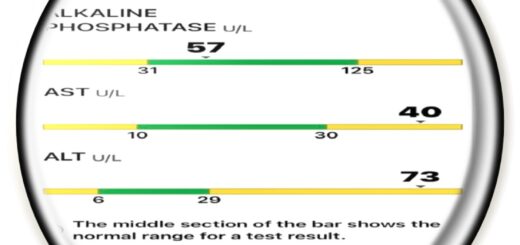Bilirubin Levels Chart (Normal, Low, High Bilirubin Levels Explained)
Bilirubin Levels Chart is a table of common bilirubin levels that cause jaundice yellowish color of the skin and eyes sclera, including normal bilirubin levels, high bilirubin levels, and low bilirubin levels in the same place.
Where bilirubin comes from and where does bilirubin go to?
Bilirubin comes from the degradation of hemoglobin and cells breakdown by spleen or other organs, bilirubin enters bloodstream as large insoluble molecule which has the term (unconjugated), when reaches the liver, hepatic cells perform chemical reaction to make bilirubin soluble in the blood by bound it to the glucuronic acid by the enzyme glucuronyltransferase which then called (conjugated), conjugated bilirubin go from the liver to the intestine and undergoes reduction to the form called stercobilirubin which give the stool its yellowish color, another part of direct bilirubin go to urine through the kidney after being transformed to a compound called urobilinogen (urine dye) which gives the urine the yellowish color.
Measuring Bilirubin at the lab: scientists measure conjugated bilirubin and report it as (direct bilirubin), and measures total bilirubin values, then calculated the unconjugated bilirubin by subtracting direct from the total, the result is the estimated indirect bilirubin (unconjugated)
When your doctor requests a bilirubin test, this means direct bilirubin (DBil), indirect bilirubin, and total-value bilirubin (TBil), the bilirubin test for the newborns is “total bilirubin and/or indirect bilirubin”

Hyperbilirubinemia, Jaundice, icterus are medical terms for high bilirubin levels in the blood and urine, clearly, jaundice means a yellow discoloration of the skin and icterus means discoloration of the eyes, while kernicterus is a medical condition that means brain cells damage due to high bilirubin levels in the blood, usually at levels such as 30 mg/dl, Bilirubin is a highly neurotoxic substance.
Medical shortcodes for TSB, DSB, ISB are total, direct, indirect serum bilirubin respectively.
Total bilirubin is the sum of all bilirubin forms in the blood and does not represent a different type of bilirubin in the body.
The bilirubin showed in urine and skin at serum bilirubin levels between 3.0 to 5.0 mg/dl, skin jaundice and eyes yellowish discoloration appear, urine color become dark yellow or as light tea when direct bilirubin is high in the blood when indirect bilirubin is higher than 25mg/dl in the blood, it may show greenish plasma color as a result of the severe elevation of indirect bilirubin (due to increased activity of biliverdin reductase enzyme which reduces biliverdin to bilirubin).

Comprehended bilirubin levels chart for all ages (adults and newborns)
Low bilirubin levels explained
Low levels of bilirubin are generally not concerning and are not monitored as there are no studies confirming the risk for a low level of bilirubin.
Bilirubin results like:
- Total bilirubin less than 0.4 is not a concern of abnormalities.
- Indirect less than 0.3 is another insignificant bilirubin level.
Normal bilirubin levels
Normal bilirubin level is a bilirubin value that means there are no diseases that could be found in the sources of synthesis, processing, and removing of bilirubin.
- normal bilirubin values lie between reference ranges, the lower limit, and the upper limit.
- Direct bilirubin 0, 0.1, 0.2, and 0.3 is normal results and cannot be a cause of jaundice unless indirect bilirubin continue to be high.
- Indirect bilirubin 0.8, 0.7, 0.6, 0.5,0.4, and 0.3 are all normal levels of blood bilirubin.
- Total bilirubin level 0.9,0.8,0.7,0.6,0.5,0, and 4.0 are normal and not jaundice whatever is the result of direct and indirect bilirubin.
Recommendation: if it’s the first time you take a bilirubin test, there is no further investigation when results is normal, if you’re on medication, then you’re just fine and continue to keep it normal.
Borderline Bilirubin results:
Are the bilirubin levels that reach the normal upper limits or slightly above, can’t be taken seriously as jaundice, and need for new test after a few days, sometimes borderline bilirubin levels show up when the person is on medications.
- Bilirubin direct 0.4 with normal indirect and total bilirubin results.
- Bilirubin indirect level is 0.9 and total is 1.0 mg/dl.
- Bilirubin total is 1.1 and normal direct and indirect bilirubin.
False bilirubin results:
Lab errors must be confirmed by retesting bilirubin after a few days, physiological causes as dehydration show pale yellow skin and deep yellow eye’s white area which may be confused with jaundice, results may be as:
- Bilirubin direct level is higher than the total bilirubin level, for instance; direct 1.0 and total 0.8 mg/dl.
- Bilirubin levels show slight increase above the upper normal limit; for ex. Total 1.1 and 1.2 mg/dl.
- Total bilirubin results are very low: 0, 0.1, 0.2, 0.3 mg/dl which could be false low results or wrong test.
High bilirubin levels (hyperbilirubinemia)
Causes of hyperbilirubinemia:
- High Direct bilirubin helps in diagnosis the liver function and post hepatic jaundice caused by obstruction of bilirubin in common bile ducts (obstructive jaundice) by gallstones, tumors, or scarring of bile ducts, also some diseases cause liver function failure such as viral hepatitis, alcoholic liver disease, and drug reactions.
- High Indirect bilirubin helps in diagnosis of pre-hepatic jaundice caused by rapid hemolysis of red blood cells of infants or adults such as hemolytic anemia, pernicious anemia, also blood transfusion reaction, and Cirrhosis cause high indirect jaundice, inability to produce the enzyme which converting indirect to direct is a common cause of jaundice without a disease, this case known as inherited Gilbert syndrome and cause relative elevation in indirect bilirubin.
High bilirubin (total) is either due to:
- High indirect bilirubin level with normal or slightly elevated direct bilirubin, commonly seen by those with excessive hemolytic anemia for any cause and newborn jaundice due to new birth immaturity or RH incompatibility between mother and baby, may be called hemolytic jaundice, for example:
- Indirect bili. 3.0 high, direct bili. 0.3 normal.
- Indirect bilirubin 10.0 very high, slightly elevated direct bilirubin 0.5 mg/dl.
2. High direct Bilirubin level with normal or slightly elevated indirect bilirubin, commonly seen in results of obstructive jaundice due to hepatitis A for children or stones, for example:
- Direct bilirubin 7.5 mg/dl high, indirect bilirubin normal 0.6 mg/dl.
- Direct bilirubin 11.0 mg/dl high, indirect bilirubin slightly elevated 0.9 mg/dl.
3. Both conjugated and unconjugated bilirubin is elevated, values are almost the same, commonly results from hepatic diseases, for instance:
- Direct bilirubin 9.0 mg/dl, indirect bilirubin 8.0 mg/dl.
- Indirect bilirubin 12.0 mg/dl, direct bilirubin 11.5 mg/dl.
Common bilirubin levels in infant newborns:
- 1 day after birth: direct 0.2, indirect 3.5 mg/dl, total is 3.7
- 2 days: direct 0.3, indirect 5.0, and total is 5.3
- 1 week to 10 days after birth: indirect 13.0, direct 1.0, and total bilirubin 14.0 mg/dl.
- 2 weeks: should be reduced towards the normal limits, if increased; may show total bilirubin over 20 mg/dl, which is very high and incubation is required, extremely elevated total bilirubin higher than 30 mg/dl is a serious condition and may lead to Kernicterus which is deadly brain damage.
For treatment and follow up tests of newborn jaundice, please visit this topic; jaundice in newborns, and bilirubin blood test results.
High bilirubin with no visible disease
Gilbert, Crigler-Najjar syndrome, and alcohols are common reasons for high bilirubin levels without an obvious disease.
- In Crigler-Najjar syndrome, at birth or in infancy the child show jaundice with Severe unconjugated hyperbilirubinemia, if bilirubin is extremely elevated can cause condition called kernicterus, the accumulation of unconjugated bilirubin in the brain and nerve tissues and lead to brain damage and death.
- In Gilbert’s syndrome: also has the medical terms constitutional hepatic dysfunction and familial non-hemolytic jaundice, seen by accident during checkup testing, the one still be confused where and when he acquired this bilirubin, all hemolytic tests and hepatic causes are absent, the bilirubin still constantly at near high levels for all the life as the original reason is “born with gene mutation caused abnormal bilirubin metabolism”
Remarks: Hereditary jaundice show steady bilirubin levels and continuous follow up.
Have you got help with this explanation? please share the knowledge, no matter if you ask for additional help.


